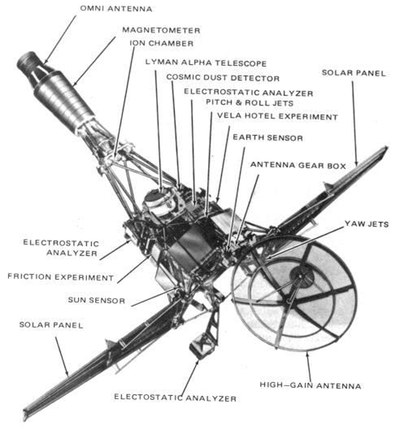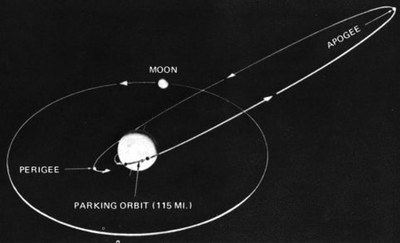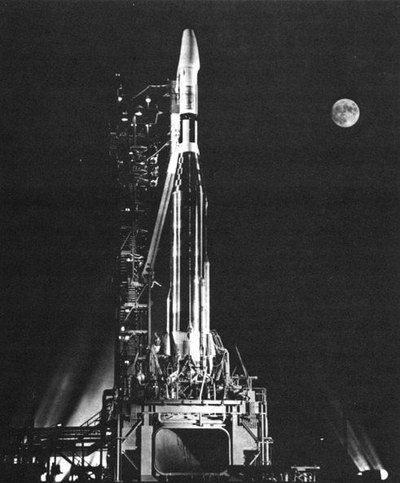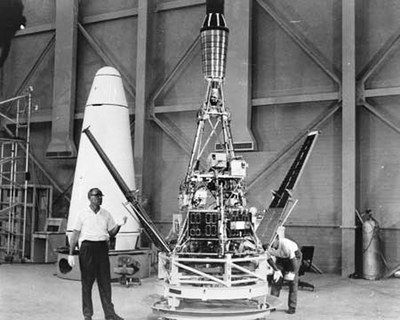Ranger: Voyage to the Moon and beyondby Andrew J. LePage
|
| The genesis of the successful Mariner spacecraft design can be traced back to over half a century ago. |
As exciting as these times are for planetary exploration enthusiasts like myself, I still remember the greater excitement of the original golden age of planetary exploration over 40 years ago. During that time, one planetary program stood out among the rest: the Mariner series managed by the Jet Propulsion Laboratory (JPL) in Pasadena, California. During the course of the 1960s to early 1970s, this series of spacecraft performed the initial reconnaissance of every planet from Mercury to Mars. The Mariner spacecraft design was subsequently modified to carry the first Mars landers in 1976 as part of the Viking program. And a pair of Mariner Jupiter-Saturn spacecraft, which were renamed Voyager before their launch in 1977, visited every other planet in the solar system, from Jupiter to Neptune (see “The Grand Tour: Uranus”, The Space Review, January 24, 2011).
The genesis of this successful spacecraft design can be traced back to over half a century ago. During 1959, while the Soviet Union managed one space first after another, the newly formed NASA was busy consolidating its new empire and formulating plans to meet the formidable Soviet challenge. Among NASA’s best assets was JPL, which had already built America’s first satellite, Explorer 1, and its only successful lunar probe, Pioneer 3, for the Army Ballistic Missile Agency (ABMA). In late December of 1959, NASA directed JPL to make plans for five lunar missions to take place in 1961 and 1962. Throughout 1959, JPL and ABMA were already studying follow-on lunar missions that would use the new three-stage Atlas-Vega launch vehicle specifically being designed for lunar and planetary missions. With the cancellation of JPL’s home-grown Atlas-Vega on December 11, 1959, these missions were switched to the soon to be available Atlas-Agena B being developed by the United States Air Force (USAF).
Two of the major problems with the launch vehicles used to date for American lunar missions were their comparatively small payload capability and their poor accuracy. The Thor-Able, Juno II, and Atlas-Able which launched the first lunar Pioneer probes were far from ideal for lunar missions (see “The Pioneer lunar orbiters: a forgotten failure”, The Space Review, December 13, 2010). They were essentially existing rockets from various sources that were quickly kludged together for the task. In addition, they could only use direct ascent trajectories to loft their payloads beyond the Earth, which resulted in large gravity losses as these rockets climbed more or less straight out of Earth’s gravity well. In addition to limiting the useful payload, this type of trajectory also greatly magnifies any velocity or aiming errors.
Ideally the upper stage and its payload would first be placed into a temporary parking orbit around Earth. The upper stage would ignite at exactly the right moment to ensure an accurate injection into an escape trajectory. With the upper stage firing approximately in line with the horizon, gravity losses are also minimized, allowing the launch vehicle to carry a larger payload compared to flying a direct ascent trajectory. Engineers in the Soviet Union also came up with the same solution and used this technique to launch their first planetary probe to Venus on February 12, 1961, using their new three-stage 8K78 rocket (see “The beginnings of planetary exploration: the first probes to Venus”, The Space Review, February 14, 2011). Although it had only about half of the payload capability of the Soviet 8K78, the American Atlas-Agena B was designed to fly the same type of trajectory.
| By the end of January in 1960, JPL’s new lunar project, called Ranger, had taken form. |
Development of the Agena upper stage began in July of 1956 under a USAF contract with the Lockheed Missiles and Space Company. This stage was specifically designed for use with a modified Thor IRBM or Atlas D ICBM as the booster. The Agena B was a greatly modified version of the original Agena A. While it kept the original 1.5-meter (5-foot) diameter, it was lengthened by two meters (6.4 feet) to 6.30 meters (20.7 feet) to support a larger propellant load. The original A model’s Bell Aerospace Hustler 8048 engine was replaced with an upgraded 8081 which generated 71 kilonewtons (16,000 pounds-force) of thrust and possessed an in-orbit restart capability.
The Thor-Agena was used to launch the Corona reconnaissance satellites into polar orbits under the guise of the Discoverer satellite series. Flights with the Thor-Agena A had started on February 28, 1959, and flew successfully ten times out of fifteen attempts before it was replaced by the improved Thor-Agena B, whose first flight took place on October 26, 1960. The Agena B demonstrated its all-important restart capability for the first time with a one-second burn on the flight of Discoverer 21, launched on February 18, 1961.
The Atlas-Agena was originally designed to place large payloads, such as the MIDAS experimental early warning satellite and the SAMOS reconnaissance satellite, into medium altitude Earth orbits. The Atlas-Agena A flew only four times between February of 1960 and January of 1961 with limited success. The first flight of the improved Atlas-Agena B took place on July 12, 1961, with the successful launch of MIDAS 3. The Atlas D was modified for this task by stiffening its forward bulkheads to handle the heavier payload and eventually Atlas’ original MA-2 propulsion systems was replaced with the uprated MA-3 system being used on the improved Atlas E/F silo-based ICBM then under development. This boosted the liftoff thrust of the 30-meter (98-foot) tall Atlas-Agena B to 1,820 kilonewtons (410,000 pounds-force). The Atlas-Agena B was capable of launching payloads of 2,300 kilograms (5,000 pounds) into a 480-kilometer (300-mile) orbit or up to about 330 kilograms (725 pounds) towards the Moon.
 Diagram of the Ranger Block I spacecraft. This spacecraft not only tested the systems needed for the Ranger lunar probes but served as the basis of JPL’s future Mariner series of planetary spacecraft. (credit: NASA) |
Ranger is born
By the end of January in 1960, JPL’s new lunar project, called Ranger, had taken form. The five flights would use two spacecraft designs, designated Block I and Block II. The first two flights would use of the Block I design. They were meant to be engineering test flights that would place Ranger into an extended Earth orbit with a perigee of 60,300 kilometers (37,500 miles) and an apogee of 1.1 million kilometers (685,000 miles). It would take Ranger about two months to complete each orbit. These 307-kilogram (675-pound) three-axis stabilized spacecraft would be the forerunner of not only the Ranger Moon probes but also provide vital engineering experience for the Mariner A and B spacecraft then being designed to explore the planets Venus and Mars, respectively.
Test flights of this spacecraft were deemed necessary to test the interface between the probe and launch vehicle, as well as determine whether all the bugs had been worked out of controlling a three-axis stabilized spacecraft in space. Three-axis stabilized spacecraft provide a more stable platform for certain instruments, such as cameras, than do spin-stabilized probes like ARPA’s and NASA’s previous Pioneer Moon probes. Typically, one axis is pointed towards the Sun to provide illumination for the spacecraft’s power producing solar panels. With the Ranger probes, the other celestial reference used to stabilize the spacecraft was the Earth itself.
At Ranger’s base was a 195-kilogram (430-pound) hexagon shaped magnesium frame bus 1.52 meters (5 feet) across. The various compartments of this bus contained the spacecraft’s central computer and sequencer, which controlled the spacecraft; a 57-kilogram (125-pound) silver-zinc battery providing nine kilowatt-hours of backup electrical energy, enough for about two days; a one-quarter-watt and a three-watt radio transmitter; and the attitude control system. Attitude reference was provided by six Sun sensors, two Earth sensors, and three gyros. Unlike subsequent versions, the Block I was not equipped with a propulsion system needed for a mid-course correction capability.
 Diagram showing the elongated 60,300 kilometers (37,500 miles) by 1.1 million kilometers (685,000 miles) orbit for the first Ranger test flights. Ranger would collect data for five months from deep space. (credit: NASA) |
Extending from the sides of the bus were two solar panels containing 8,680 solar cells to provide up to 210 watts of power for the spacecraft. Also extending from the base was a hinged dish-shaped high-gain communications antenna 1.22 meters (4 feet) across, which would be pointed at Earth with the aid of a light sensor. The spacecraft maintained its attitude using ten gas jets supplied by 1.1 kilograms (2.4 pounds) of compressed nitrogen held in three tanks.
| Although not meant to operate in low orbit with its ninety-minute day-night cycle, Ranger 1 did attempt to operate as intended. |
On top of the bus was an open aluminum truss structure topped with a low-gain antenna to aid in communications with Earth when the probe’s high-gain antenna could not be used. When deployed in space, the Block I spacecraft was about four meters (13 feet) tall and 5.2 meters (17 feet) across its extended solar panels. The spacecraft carried ten scientific instruments to study solar and cosmic radiation, cosmic dust, magnetic and electric fields, and perform engineering tests concerning mechanical friction and solar cell performance. These experiments were mounted at various points on the bus and open truss structure. Some of these devices carried independent battery power supplies. These instruments would collect data during Ranger’s expected five-month lifetime.
The 330-kilogram (725-pound) Ranger Block II spacecraft would actually travel to the Moon starting in early 1962. The basic bus was similar to the one used on the Block I probe, but the open truss structure above it was replaced with a new payload: A 150-kilogram (330-pound) package consisting of a small hard lander with a solid propellant retrorocket that generated 23 kilonewton (5,080 pounds-force) of thrust. The hard lander, built by Ford Aeronutronic, was a 64-centimeter (25-inch) diameter sphere weighing 43 kilograms (94 pounds). Its sole instrument was a seismometer to measure lunar quakes once it had safely reached the lunar surface. Before the lander was deployed, the Ranger Block II would acquire data about the Moon, including television images as the spacecraft approached the surface.
 Atlas 117D/Agena B 6002 at Launch Complex 12 at Cape Canaveral during the countdown to launch Ranger 2 on November 18, 1961. (credit: NASA) |
The first flights
By the summer of 1961, the first Ranger, designated P-32, and its launch vehicle were ready. The initial launch period ran from July 26 to August 2 with daily launch windows running 4:53 to 5:37 AM EDT. In late June, Agena B 6001 was placed atop of Atlas 111D at Launch Complex 12 at Cape Canaveral. This was to be the second flight of the Atlas-Agena B. Ranger 1 eventually topped off the stack and on July 13 the rocket and probe were judged ready for launch.
The first attempt on July 29 was scrubbed a few minutes before launch due to a power failure on the ground. Three more launch attempts over the next three days were made and scrubbed. During testing of Ranger’s scientific instruments during the countdown of the fourth launch attempt on August 1, a voltage spike inadvertently turned on the spacecraft’s timer. Explosive squibs detonated to extend the solar panels inside the launch shroud and the craft’s instruments all came to life. The Ranger had to be returned to the hangar where it was quickly repaired and the faults corrected for the next set of launch opportunities starting on August 22. Finally, at 6:04 AM EDT on August 26, 1961, Ranger 1 lifted off into a perfect 174 by 280-kilometer (108 by 174-mile) parking orbit.
After coasting for thirteen minutes, the Agena B escape stage was supposed to reignite for ninety seconds and propel Ranger 1 into deep space. But a faulty pressure switch circuit in the Agena’s engine starting system prevented a valve from opening. Apparently the circuit overheated while exposed to the Sun during Agena’s coast in parking orbit—a situation that engineers had not anticipated. The engine fired only briefly to change the orbit to 169.4 by 502.8 kilometers (105.3 by 312.5 miles). Stranded in low Earth orbit, Ranger 1 separated from its escape stage, obediently unfolded it solar panels and aligned itself with the Sun.
Although not meant to operate in low orbit with its ninety-minute day-night cycle, Ranger 1 did attempt to operate as intended. Every time it went into Earth’s shadow, nitrogen jets would fire as the disoriented Ranger mindlessly started searching for the Sun. After orbital dawn, Ranger would reacquire the Sun and stabilize. While it was operating as well as it could under the circumstances, Ranger depleted its supply of attitude control gas the day after launch and started tumbling uncontrollably.
After 111 orbits, Ranger 1 succumbed to atmospheric drag, fell out of orbit, and burned up over the Gulf of Mexico on August 30. During its brief life, Ranger 1 did verify that a three-axis spacecraft could be controlled. It was also able to collect a limited amount of data on radiation and cosmic rays but was too close to Earth for its magnetometer to operate.
As the Ranger 1 mission ended prematurely, Atlas 117D, Agena B 6002, and payload P-33 arrived at Cape Canaveral for a launch period extending from October 20 through 28. One problem after another caused one launch scrub after another. Finally, a launch failure of a Thor-Agena B indicated that there were problems with the Agena B hydraulic system that would require time to correct. The launch of Ranger 2 was pushed back to mid-November.
| While the two Ranger Block I spacecraft never made it beyond their parking orbits, they did provide enough engineering information to verify the basic design of a three-axis stabilized spacecraft. |
With the repairs to the Agena B 6002 completed, Ranger 2 was finally launched at 3:12 AM EST on November 18, 1961, and entered its parking orbit. Again the Agena B failed to restart properly and Ranger 2 was stuck in a quickly decaying 152.7 by 234.4-kilometer (94.9 by 145.7-mile) orbit. This time the problem was traced to a roll gyro in the Agena B stage whose malfunction had gone undetected at launch. With no way to sense a rolling motion, the Agena B started spinning, forcing its propellants to the outside edges of its tanks instead of to the bottom, where the feed lines to the engine were located. When the command to reignite was given, only a brief firing resulted, due to residual propellant in the turbopumps. Like the Soviet engineers had learned from their experience with the 8K78, American engineers were discovering that developing an in-orbit restart capability would not be easy. More bugs had to be worked out of the Atlas-Agena B. No tests were attempted this time and the wayward Ranger 2 deep space probe burned up in the atmosphere only six hours after launch.
While the two Ranger Block I spacecraft never made it beyond their parking orbits, they did provide enough engineering information to verify the basic design of a three-axis stabilized spacecraft. It was also clear that the Atlas-Agena B was having problems that needed to be addressed before more missions could be launched. When it became clear that the powerful Atlas-Centaur would not be available in time to launch the 500-kilogram (1,100-pound) Mariner A towards Venus in August of 1962, NASA switched to a backup design called “Mariner R” that could be launched using the smaller Atlas-Agena B. Mariner R was essentially a stripped down, modified Ranger Block I spacecraft weighing just 204 kilograms (448 pounds) and carrying a minimal science instrument payload of about 9 kilograms (20 pounds). A similar design was eventually used for the first Mariner probes to Mars in 1964 and on all the Mariner spacecraft to follow over the next 13 years. In the mean time, JPL prepared to launch three Ranger Block II spacecraft to attempt the first lunar landings in 1962.
Bibliography
R. Cargill Hall, Lunar Impact: The NASA History of Project Ranger, Dover Publishing, 2010
J.D. Hunley, U.S. Space-Launch Vehicle Technology: Viking to Space Shuttle, University Press of Florida, 2008
Paolo Ulivi with David M. Harland, Lunar Exploration: Human Pioneers and Robotic Surveyors, Springer-Praxis, 2004
